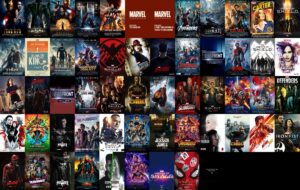Marvel’s Cinematic Playground: The Art of Balancing Humor and Drama

- The Best Movie Posters From Recent MCU Films
- The Biggest Fan Theories About Marvel’s Upcoming Movies
- The Role Of Family In MCU’s Recent Movies
- How Marvel’s Latest Movie Connects To The Comics
- Diving Into The Marvel Universe’s Latest Blockbuster
The Marvel Cinematic Universe (MCU) has grown exponentially over the years, captivating audiences worldwide with its iconic characters, gripping storylines, and meticulous attention to detail. However, behind the success of these films lies a delicate balance between humor and drama – a tightrope act that Marvel has mastered with remarkable finesse. So, what’s the secret to this fascinating blend of laughter and tears?
In the early days of the MCU, Marvel relied heavily on humor to break the ice and establish a connection with viewers. Films like Iron Man (2008) and Guardians of the Galaxy (2014) showcased a lighter, more playful side of superheroes, using wit and satire to great effect. But as the universe expanded, Marvel began to tackle more mature themes, incorporating darker, more complex narratives into its storylines.
This shift is evident in movies like Avengers: Infinity War (2018) and Avengers: Endgame (2019), which dealt with the consequences of catastrophic failure and the weight of existential loss. These films demonstrated Marvel’s willingness to take risks and push the boundaries of what was considered acceptable in a superhero movie. The result was a powerful, emotionally resonant experience that left audiences reeling.
So, how does Marvel balance these seemingly opposing elements – humor and drama? For starters, the studio has an uncanny ability to read its audience. Marvel understands that viewers crave a mix of entertainment and substance, and its writers work tirelessly to craft stories that tick both boxes. By using humor as a release valve, the studio can diffuse tension and create moments of levity, making the transition to more dramatic scenes feel organic and authentic.
Another key factor is the MCU’s well-developed cast of characters. Each superhero has a distinct personality, quirks and all, allowing actors to bring their A-game to every scene. When done correctly, this character-driven approach can create a sense of familiarity and emotional investment, making the audience more receptive to the ups and downs of the story.
Take the character of Tony Stark, for example. Played by Robert Downey Jr., Tony’s quick wit and sarcasm provided much-needed comic relief in the early days of the MCU. However, as the series progressed, Tony’s complexities and vulnerabilities came to the forefront, revealing a deeper, more nuanced character. This dual approach allowed Marvel to balance humor and drama with ease, creating a rich, multifaceted character study that resonated with audiences.
Furthermore, Marvel has an exceptional understanding of pacing and tone. By expertly juggling action sequences, quiet moments, and shocking plot twists, the studio can modulate the mood of a scene or entire film with remarkable precision. This know-how allows Marvel to navigate even the most sensitive or heavy-handed themes without feeling exploitative or tone-deaf.
In addition to these factors, Marvel has been savvy about acknowledging its own absurdity. By winking at the camera or subverting genre conventions, the studio can create a sense of self-awareness that acknowledges the fantastical nature of these movies. This clever move allows viewers to laugh along with the absurdity of it all, while also appreciating the more poignant moments.
In conclusion, Marvel’s success in balancing humor and drama can be attributed to its uncanny ability to understand its audience, coupled with its expertise in crafting well-rounded characters and navigating complex themes. As the MCU continues to evolve, we can expect even more innovative storytelling and tone-bending magic. With Marvel’s proven track record, we’re in for a thrilling ride – one that will make us laugh, cry, and maybe even reflect on the human condition.




